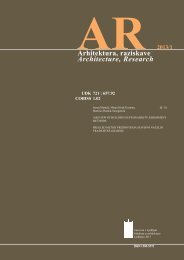Revija 2005/1 v PDF - Fakulteta za arhitekturo - Univerza v Ljubljani
Revija 2005/1 v PDF - Fakulteta za arhitekturo - Univerza v Ljubljani
Revija 2005/1 v PDF - Fakulteta za arhitekturo - Univerza v Ljubljani
You also want an ePaper? Increase the reach of your titles
YUMPU automatically turns print PDFs into web optimized ePapers that Google loves.
AR 2oo5 / 1Peter Gabrijelèiè, Alenka Fikfak, Gregor ÈokUREJANJE PODEELSKIH NASELIJ -NASELJA BREZ SREDIŠÈNEGA POMENAMANAGEMENT OF SETTLEMENTS IN THE COUNTRYSIDE -SETTLEMENTS WITHOUT CENTRAL SIGNIFICANCEraziskava, researchpovzetekS preobrazbo socialne in ekonomske strukture podeelja sepreoblikujejo tudi ustaljene prostorske oblike naselij brezsredišènega pomena (funkcionalna, arhitekturna in urbanistièna<strong>za</strong>snova). Spremembe so pozitivne in negativne, <strong>za</strong>to je potrebnooblikovati primerno metodologijo, ki bo s pomoèjo analitiènihindikatorjev in selektivnih kriterijev omogoèala regulacijoaktualnih prostorskih trendov.Tipi podeelske poselitve ter agrarnih naselij in njihovihsestavnih delov so prav gotovo bistven element kulturne krajine, vkateri so se skozi zgodovinska obdobja menjavale razliènecivili<strong>za</strong>cije v obliki nenehne kulturne sedimentacije. V odvisnostiod spreminjajoèih se proizvodnih odnosov prihaja do nenehneintegracije starejših in mlajših oblik organi<strong>za</strong>cije prostora in s temdo izoblikovanja novih kvalitet v odnosu med oblikami poselitve,rabo tal in socialno èlenitvijo.doseeni cilji, namen in rezultatiZ oblikovanjem tipologije krajin smo ugotavljali razmerja mednaravno in kmetijsko krajino ter vpetost posameznih naselij vsistem poselitve. Kljuèni ukrepi <strong>za</strong> urejanje naselij in njihovihvplivnih obmoèij so odvisni od temeljne strategije oziromaprimarne razvojne usmeritve krajine. Praktièen rezultat nalogepredstavlja karta s prikazom tipologije podeelskih krajin inpodeelskih naselij, s pomoèjo katere je mogoèe okvirno opredelitikarakter vseh posameznih obmoèij v prostoru Slovenije. Taèlenitev prostora predstavlja izhodišèe <strong>za</strong> definiranje podrobnejšihmeril/pravil <strong>za</strong> urejanje manjših naselij glede na njihovotipologijo, kulturno-krajinske tipe in glede na specifiko lokacije.problematika v arhitekturi, umestitevobravnavane teme v te tokove in njen pomenKljuèni problem podroèja raziskave je poleg urejanja"prostorskih trendov", ki jih povzroèajo aktualne socioekonomskespremembe tudi prehod iz ustaljene planerske praksein spremljajoèih upravnih postopkov v nov sistem prostorskeganaèrtovanja in urejanja prostora.Naloga razkriva pomanjkljivosti obstojeèe <strong>za</strong>konodaje napodroèju podrobnejših pravil urejanja prostora. V Splošnihpravilih prostorskega naèrtovanja (SPRO, PRO) so izrazitopoudarjeni varstveni vidiki, manj pa je izpostavljena arhitekturnain urbanistièna presoja (zlasti pri presoji variantnih rešitev, ki so<strong>za</strong>htevane v doloèenih postopkih). Arhitekturna in urbanistiènastroka mora v navedenih postopkih izdelave posameznihprostorskih aktov pridobiti vidnejšo vlogo, saj je vprašanjeestetskih (oblikovnih) meril <strong>za</strong> podobo prostora kljuènega pomena(razpoznavnost identitete, skladnost z obstojeèo celoto, strukturnespremembe, ki so e v teku ali so naèrtovane, prisotnost vizualnihpoudarkov, simbolna vrednost itd.).kljuène besedepodeelje, poselitveni vzorci, urejanje prostora, naselja brezsredišènega pomena, tipologija podeelskih krajinsummaryTransformation of the countryside's social and economicstructure is also coupled with transformation of established spatialforms of settlements without central significance (functional,architectural and urbanistic layout). Changes are positive andnegative. It is therefore necessary to devise a more adequatemethodology, which will, supported by analytical indicators andselective criteria, enable regulation of present spatial trends.The type of settlement in the countryside and agrariansettlement, as well as their composite parts, is surely the essentialelement of a cultural landscape, in which throughout historicalperiods, different civilisations replaced each other in the form ofconstant cultural sedimentation. Depending on changingproduction relations there is a constant integration of older andyounger forms of spatial organisation and correspondingly theformation of new qualities related to forms of settlement, land useand social structuring.intentions, goals and resultsIn designing the landscape typology we determined therelations between natural and cultural landscapes and theintegration of independent settlements in the settlement system.The key measures for management of settlements and theirinfluential areas depend on the fundamental strategy andlandscape's priority development direction. The research'spractical result is a map showing typologies of countrysidelandscapes and pertaining settlements, which can be used to givegeneral definitions of the character of all the separate areas inSlovene territory. This structuring represents a starting point fordefining more detailed measures/rules for management of smallersettlements with respect of their typology, cultural-landscape typeand specifics of their setting.architectural issues, positioning the topicin ongoing debate and its’ significanceBesides management of "spatial trends" caused by ongoingsocial-economic changes the key researched issue was transitionfrom present planning practise and corresponding administrativeprocedures to the new system of spatial planning and management.The research discloses deficiencies of valid laws in the segmentof detailed rules regulating spatial management. In the generalrules of spatial management (Strategy, order) protective aspectsare exceptionally emphasised, while architectural and urbanisticassessment are hardly mentioned (especially in assessment of ideaproposals, which are demanded in certain procedures). Thearchitectural and urbanistic practices have to be given a moresubstantial role in the production procedures of such planningacts, after all issues of aesthetic (design) measures for spatialimage are of vital importance (distinction, identity, harmony withthe extant entity, ongoing or planned structural changes, presenceof landmarks, symbolic value etc.).key wordscountryside, settlement patterns, spatial management,settlement without central significance, typology of countrysidelandscape65
















